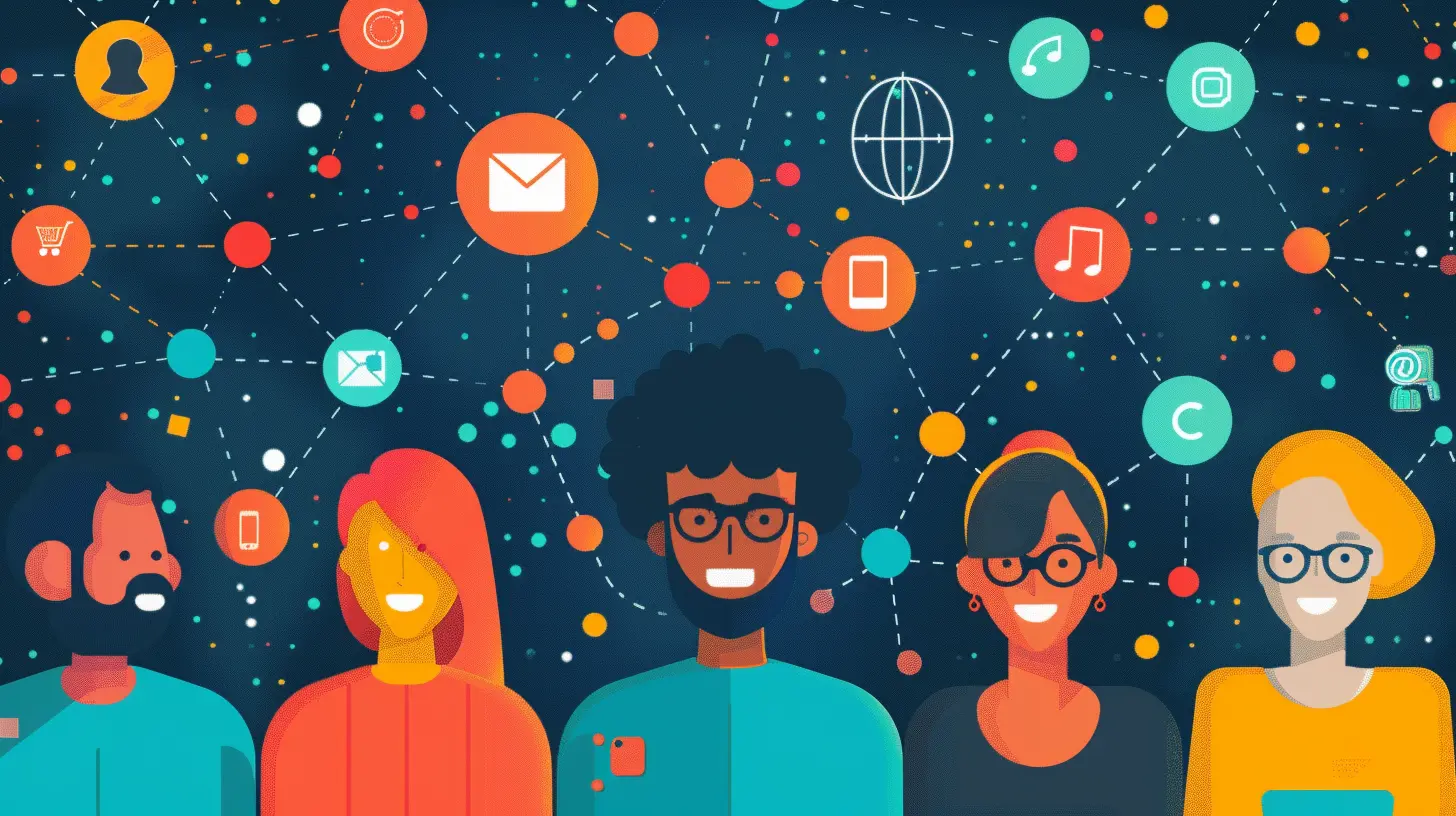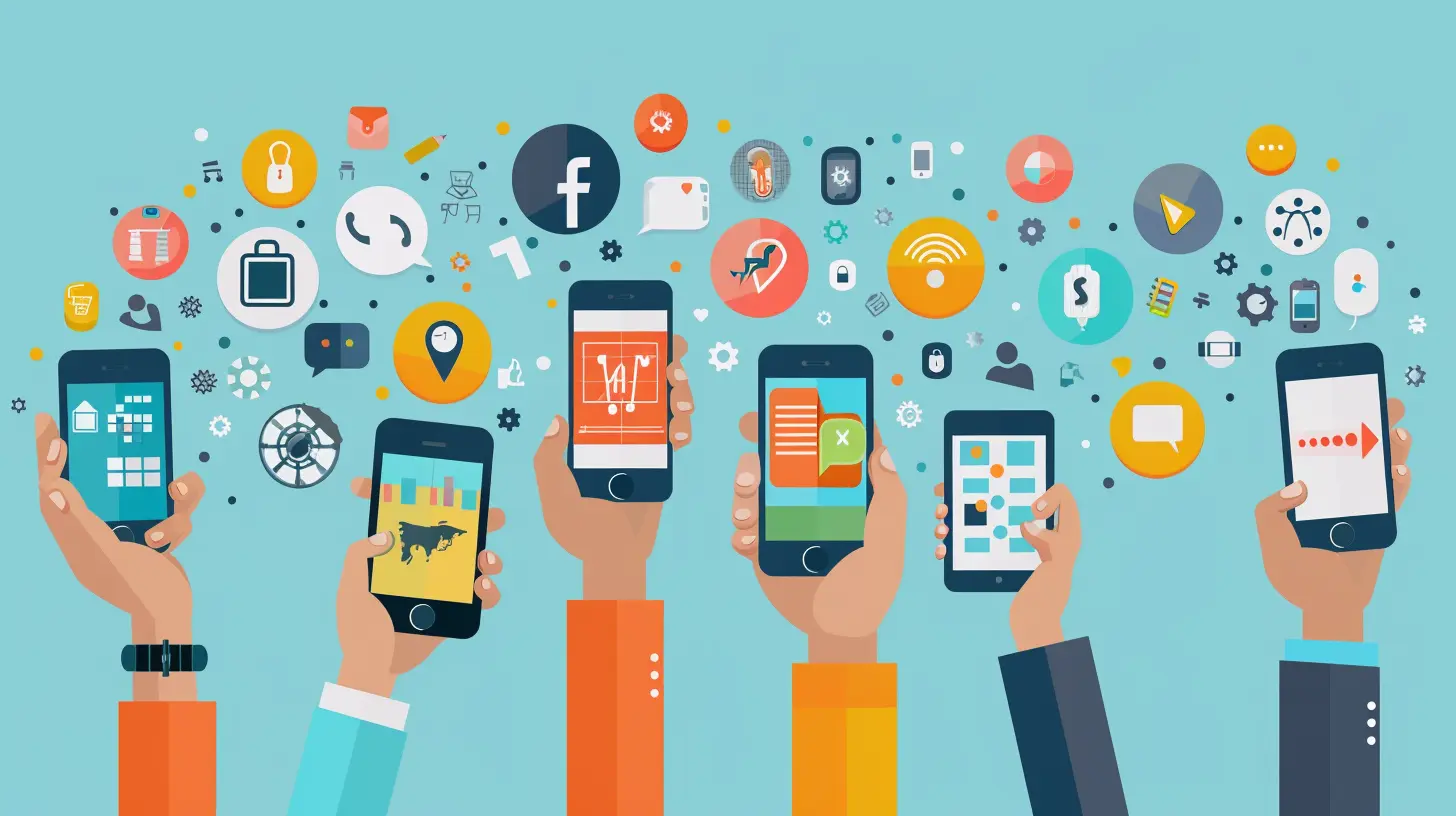How Customer Data Platforms are Powering Personalization in the Digital Age
17 February 2025
In today’s fast-paced, ever-evolving digital world, personalization has become the holy grail of customer experiences. You’ve probably noticed this yourself: whether you're shopping online, scrolling through social media, or even reading an email, it often feels like the internet knows exactly who you are and what you want. Spoiler alert—it kind of does! At the heart of this magic is something that’s revolutionizing the way businesses interact with us: Customer Data Platforms (CDPs).
But how exactly are these platforms powering this hyper-personalized experience that we’ve come to expect in the digital age? And why are CDPs such a big deal for businesses and consumers alike? Let’s dive deep into the world of CDPs, and see how they’re shaping the future of personalization.

What Is a Customer Data Platform (CDP)?
First, let’s get the basics down. A Customer Data Platform (CDP) is a software solution that collects, organizes, and unifies customer data from various sources into one central hub. Think of it as a giant filing cabinet, but way smarter. It not only organizes this data neatly but also makes it accessible and actionable for marketing, sales, and customer service teams.The key feature here is that CDPs create customer profiles—rich, detailed, and up-to-date profiles that can track an individual’s behavior across multiple touchpoints, whether that’s a website, mobile app, social media, or email. It’s like having a personal assistant who keeps track of all your preferences and interactions across a range of platforms.
Now that we’ve established what a CDP is, let’s get to the fun part—how these platforms are fueling personalization in our digital lives.

The Shift Toward Personalization
Let’s face it: we live in the age of instant gratification. Consumers today expect personalized experiences that speak directly to their needs and preferences. Gone are the days when generic advertising or one-size-fits-all marketing could cut through the noise. In fact, according to a study by Accenture, 91% of consumers are more likely to shop with brands that provide relevant offers and recommendations.Personalization isn't just a “nice-to-have” anymore—it’s a must-have. And this is where CDPs flex their muscles. They enable businesses to understand their customers on a granular level, and then deliver highly tailored experiences based on that understanding.
Why Traditional Systems Fall Short
Before the rise of CDPs, businesses primarily relied on Customer Relationship Management (CRM) systems or Data Management Platforms (DMPs). While these tools are still useful, they have significant limitations when it comes to personalization.- CRMs are great at storing data like purchase history and contact information but lack the ability to track real-time behaviors or interactions across multiple channels.
- DMPs primarily work with anonymized data (think cookies) and are designed to manage advertising campaigns rather than provide a complete view of individual customers.
In contrast, CDPs take a more holistic approach. They integrate data from various sources—structured and unstructured—creating a 360-degree view of each customer. This unified view is the secret sauce that powers personalization.

How CDPs Drive Personalization
Now that we have a better understanding of what a CDP is, let’s break down how it actually powers personalization.1. Data Unification: A Single Customer View
At the core of any personalization effort is data. But not just any data—unified data. CDPs collect information from various channels (e.g., your website, mobile app, email campaigns, social media interactions) and bring it all together into a single customer profile. This means that instead of having fragmented pieces of data scattered across different systems, CDPs provide a comprehensive view of each customer.For example, let’s say you’re browsing a clothing website on your laptop, and you add a few items to your cart but don’t complete the purchase. Later, you open the brand’s app on your smartphone. A CDP can recognize you as the same user across both devices and may trigger a push notification reminding you about your abandoned cart. This unified view enables brands to communicate with you in a consistent and personalized way, regardless of the platform you’re using.
2. Real-Time Personalization: Right Moment, Right Experience
Timing is everything, right? CDPs excel at real-time personalization, which is key to delivering relevant experiences at just the right moment. Thanks to the ability to collect and process data in real-time, CDPs allow businesses to react instantly to customer behavior.For example, if a customer shows interest in a particular product category by browsing certain pages on a website, a CDP can trigger personalized emails or in-app notifications offering similar products or special discounts on items in that category. This is way more effective than sending a generic email blast to your entire customer base, hoping something sticks.
3. Segmentation: Hyper-Targeted Campaigns
CDPs make it easier than ever to segment customers based on a variety of factors, including demographics, behavior, purchase history, and engagement levels. This allows businesses to create highly targeted marketing campaigns that speak directly to specific customer segments.For instance, a CDP can help a grocery retailer identify a group of customers who frequently buy organic produce and send them personalized offers or recipes featuring organic products. By delivering content that speaks directly to their preferences, the retailer can increase engagement and drive sales.
4. Omnichannel Experience: Consistency Across Touchpoints
We live in an omnichannel world, where customers frequently switch between devices and platforms. CDPs ensure that these transitions are seamless and that the experience remains consistent across all touchpoints.Let’s take an example from the travel industry. Imagine you’re planning a vacation and you start by researching flights on your desktop. Later, you continue your search on your mobile device, and finally, you book your flight using the airline’s mobile app. A CDP allows the airline to keep track of your journey across these different platforms, ensuring a consistent and personalized experience at every step of the way. You might receive tailored recommendations for hotels or car rentals based on your previous searches—no matter which device you’re using.
5. Predictive Analytics: Anticipating Customer Needs
One of the most exciting aspects of CDPs is their ability to leverage predictive analytics. By analyzing past behavior and identifying patterns, CDPs can anticipate what a customer is likely to do next, enabling businesses to proactively deliver personalized experiences.For example, a CDP might predict that a customer who frequently purchases winter sports gear is likely to be interested in ski equipment as the winter season approaches. The business can then send personalized recommendations or promotions before the customer even starts shopping for those items. This not only enhances the customer experience but also drives sales by anticipating needs and presenting relevant options.

The Benefits of CDPs for Businesses
While the customer benefits from a personalized experience, businesses also stand to gain a lot from implementing CDPs. Here are some of the key advantages:1. Increased Customer Loyalty
When customers feel understood and valued, they’re more likely to stick around. By delivering personalized experiences, businesses can increase customer loyalty and retention. A CDP allows companies to build stronger relationships with their customers by delivering content that resonates on a personal level.2. Improved Marketing ROI
The more relevant your marketing efforts are, the less money you waste on ineffective campaigns. By using CDPs to deliver hyper-targeted and personalized campaigns, businesses can see a significant improvement in marketing ROI. After all, a campaign that speaks directly to a customer’s needs and preferences is far more likely to convert than a generic one.3. Enhanced Customer Insights
CDPs provide businesses with a wealth of data that can be used to gain deeper insights into customer behavior. By analyzing this data, businesses can make more informed decisions about their marketing strategies, product offerings, and customer service efforts.4. Scalable Personalization
One of the biggest challenges with personalization is scaling it across a large customer base. With a CDP, businesses can automate much of the personalization process, making it easier to deliver tailored experiences to thousands or even millions of customers without requiring a significant increase in resources.Challenges and Considerations
Of course, no technology is perfect, and CDPs are no exception. Businesses should be aware of the following challenges:1. Data Privacy and Regulations
With great data comes great responsibility. As CDPs collect vast amounts of personal information, businesses must ensure they comply with data privacy regulations like GDPR or CCPA. Transparency and consent are key to maintaining trust with customers.2. Data Quality and Integration
The effectiveness of a CDP depends on the quality of the data it collects. Inaccurate, outdated, or incomplete data can hinder personalization efforts. Additionally, integrating data from multiple sources can be complex and may require significant technical expertise.
The Future of Personalization with CDPs
There’s no doubt that Customer Data Platforms are transforming the way businesses approach personalization. As the digital landscape continues to evolve, and consumers expect even more tailored experiences, CDPs will play an increasingly important role in helping businesses meet these demands.Looking ahead, we can expect CDPs to become even more powerful with the integration of AI and machine learning technologies. These advancements will allow for even more precise predictions and personalization, helping businesses stay ahead of the curve.
In the end, one thing is clear: CDPs are not just a trend, they’re a necessity for any business looking to thrive in the digital age.
all images in this post were generated using AI tools
Category:
Digital TransformationAuthor:

Reese McQuillan
Discussion
rate this article
20 comments
Marie Hines
Ah, Customer Data Platforms—the magic wands of the digital realm! Who knew data could be so charming? With a sprinkle of algorithms and a dash of insights, they transform businesses into mind-readers, delivering personalized experiences like your favorite barista remembering your go-to order. Here’s to data making us feel special!
April 5, 2025 at 2:57 AM

Reese McQuillan
Thank you for your delightful comment! Customer Data Platforms truly are transformative, turning raw data into meaningful, personalized experiences that make each customer feel valued. Cheers to the magic of data!
Marni McLaughlin
Customer Data Platforms: the unsung heroes of personalization in our digital landscape. By unifying fragmented data, they empower brands to deliver tailored experiences that resonate. In an era where one-size-fits-all falls flat, these platforms are not just tools—they’re the architects of meaningful customer connections.
March 18, 2025 at 4:56 AM

Reese McQuillan
Thank you for your insightful comment! Indeed, Customer Data Platforms play a crucial role in enhancing personalization by unifying data and enabling brands to forge deeper connections with their customers.
Thalia McCaffrey
Great insights! The rise of Customer Data Platforms is truly transforming how businesses connect with their audiences. By harnessing data for personalized experiences, companies can build deeper relationships and drive engagement like never before. Exciting times ahead as technology empowers meaningful interactions in the digital age!
March 17, 2025 at 5:14 AM

Reese McQuillan
Thank you for your thoughtful comment! I completely agree—Customer Data Platforms are indeed revolutionizing engagement and fostering deeper connections through personalization. Exciting times ahead!
Destiny Cannon
Great insights on CDPs! Personalization truly enhances the customer experience.
March 16, 2025 at 9:29 PM

Reese McQuillan
Thank you! I'm glad you found the insights valuable. Personalization is indeed a game-changer in enhancing customer experiences!
Courtney Miller
Great insights! Customer Data Platforms truly revolutionize personalization and enhance customer experiences.
March 13, 2025 at 11:47 AM

Reese McQuillan
Thank you! I'm glad you enjoyed the article—CDPs really are game changers for personalization!
Uri Huffman
Customer Data Platforms: because knowing your customers better than their mothers is the secret sauce for digital success!
March 10, 2025 at 9:33 PM

Reese McQuillan
Absolutely! Understanding your customers deeply is key to delivering personalized experiences, and Customer Data Platforms are essential for achieving that level of insight.
Giovanna James
Great insights on CDPs! They truly enhance personalization efforts, making customer experiences more tailored and engaging in today’s digital landscape.
March 9, 2025 at 12:07 PM

Reese McQuillan
Thank you! I'm glad you found the insights helpful—CDPs are indeed transforming how we personalize customer experiences.
Lila Kirk
Great insights! Customer Data Platforms truly enhance personalized experiences in today's digital landscape.
March 7, 2025 at 5:10 AM

Reese McQuillan
Thank you! I'm glad you found the insights valuable. Customer Data Platforms are indeed essential for creating tailored experiences.
Elena McGuffin
Customer Data Platforms represent a transformative leap in the digital landscape, melding vast data streams into a coherent narrative. This evolution not only enhances personalization, but also raises ethical questions about data privacy and consumer trust, challenging us to balance innovation with responsibility in our connected world.
March 5, 2025 at 1:18 PM

Reese McQuillan
Thank you for your insightful comment! Indeed, while Customer Data Platforms enhance personalization, we must prioritize ethical considerations to maintain consumer trust in this evolving digital landscape.
Iliana McMahan
Customer Data Platforms are like personal stylists for your marketing! They tailor experiences to fit your audience perfectly, ensuring every digital interaction feels custom-made. It's personalization at its finest, making brands like your favorite pair of jeans—just right!
March 4, 2025 at 5:55 AM

Reese McQuillan
Absolutely! Customer Data Platforms truly enhance personalization, allowing brands to connect with their audience in meaningful, tailored ways—much like a perfect fitting pair of jeans.
Ava Walker
Customer Data Platforms are revolutionizing personalized marketing by harnessing diverse data sources, enabling brands to craft more relevant experiences. This data-driven approach fosters deeper customer engagement and loyalty in a competitive landscape.
February 28, 2025 at 7:56 PM

Reese McQuillan
Thank you for your insightful comment! Indeed, Customer Data Platforms are vital for creating tailored marketing experiences and enhancing customer engagement in today's competitive environment.
Ivory Warner
Great article! It's inspiring to see how Customer Data Platforms are transforming the way brands connect with their audiences. Personalization is key in today's digital landscape, and your insights highlight the importance of leveraging data effectively. Excited to see how this trend continues to evolve! Keep up the fantastic work!
February 28, 2025 at 1:08 PM

Reese McQuillan
Thank you so much for your kind words! I'm glad you found the insights valuable. Exciting times ahead for personalization!
Thaddeus Kearns
Customer Data Platforms (CDPs) are revolutionizing personalization by consolidating fragmented data sources, enabling brands to create cohesive customer profiles. This facilitates targeted marketing strategies and enhances customer experiences, ultimately driving engagement and loyalty. As digital landscapes evolve, CDPs are essential for competitive advantage.
February 27, 2025 at 4:36 AM

Reese McQuillan
Thank you for your insightful comment! You're spot on—CDPs are indeed transforming personalization by unifying data and enabling brands to deliver more targeted and engaging experiences.
Calder Gonzalez
Customer data platforms: because generic just doesn’t cut it anymore!
February 22, 2025 at 12:20 PM

Reese McQuillan
Absolutely! Customer data platforms enable brands to deliver tailored experiences that resonate with individual preferences, moving beyond generic approaches to truly engage customers.
Zanthe McIntyre
How do they work?
February 21, 2025 at 8:57 PM

Reese McQuillan
Customer Data Platforms (CDPs) collect and unify customer data from various sources, creating a single customer view. This enables businesses to analyze behaviors and preferences, allowing for tailored marketing and personalized experiences.
Elijah Dodson
Great insights! Customer Data Platforms are indeed transforming personalization, enabling brands to connect authentically with consumers. Exciting times ahead in digital marketing!
February 21, 2025 at 5:01 AM

Reese McQuillan
Thank you! I’m glad you found the insights valuable. Indeed, CDPs are a game changer for authentic consumer connections in digital marketing!
Tempest Smith
This article beautifully highlights the essential role of Customer Data Platforms in enhancing personalization. It's heartening to see technology fostering deeper connections between brands and customers, ultimately creating more meaningful and tailored experiences in our increasingly digital world.
February 19, 2025 at 8:44 PM

Reese McQuillan
Thank you for your thoughtful comment! I'm glad you found the article insightful on the vital role of Customer Data Platforms in enhancing brand-customer connections.
Renata Bowers
Great article! It’s fascinating to see how Customer Data Platforms are transforming personalization in today’s digital landscape. Understanding customer needs and preferences has never been more crucial. Excited to see how these innovations continue to enhance user experiences and drive engagement!
February 19, 2025 at 11:59 AM

Reese McQuillan
Thank you for your thoughtful comment! I’m glad you found the article insightful—exciting times ahead for personalization!
Astralis Schultz
This article effectively highlights the critical role Customer Data Platforms (CDPs) play in enhancing personalization strategies. By centralizing customer insights, CDPs empower businesses to tailor experiences more accurately. However, it’s essential to balance personalization with privacy, ensuring customer trust remains a top priority.
February 17, 2025 at 1:21 PM

Reese McQuillan
Thank you for your insightful comment! I completely agree that while CDPs enhance personalization, prioritizing privacy and building customer trust are crucial for sustainable success.
Velma Forbes
Ah, Customer Data Platforms: the magic wands of the digital realm! They sprinkle personalization fairy dust all over our online experiences. Imagine a world where your favorite cat memes find you, thanks to data sorcery—who knew tech could be this whimsical?!
February 17, 2025 at 5:20 AM

Reese McQuillan
Absolutely! Customer Data Platforms do bring a touch of magic to personalization, making sure we’re always delighted with the content that resonates with us. It's a whimsical blend of data and creativity!
MORE POSTS

From Legacy Systems to the Cloud: Modernizing IT Infrastructure

How AI-Generated Art Is Redefining Creativity

The Promise of Solid-State Batteries in Next-Gen Gadgets

Why Insider Threats Are the Biggest Challenge in Data Security

The Advantages of DDR5 RAM: Should You Upgrade Now?

Securing Your Cloud Storage: Best Practices for Data Safety

How AI is Revolutionizing Virtual Assistants in the Workplace

The Science Behind Bluetooth Range: How Far Can You Go?

How Space Tourism Will Be Powered by Cutting-Edge Tech

How Digital Transformation is Disrupting the Financial Services Industry

The Best Smartphones for Virtual and Augmented Reality Experiences

Hidden Gems: Lesser-Known Video Editing Tools You Should Try